SQL练习题 51题 一刷
Student表:
select * from student;
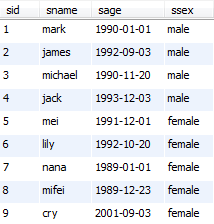
课程表Course:
select * from course;
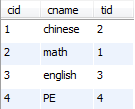
教师表teacher:
select * from teacher;

成绩表Score:
select * from sc;

1、查询" 01 "课程比" 02 "课程成绩高的学生的信息及课程分数
select c.*, a.score
from sc a, sc b, student c
where a.sid=b.sid and c.sid=a.sid and a.cid=1 and b.cid=2 and a.score>b.score; #笛卡尔积形式的连接,不能加上a.cid=b.cid
2、查询同时选" 01 "课程和" 02 "课程的学生
select a.sid
from sc a, sc b
where a.sid=b.sid and a.cid=1 and b.cid=2;
3、查询选修了" 01 "课程但可能没有选修" 02 "课程的学生情况(不存在时显示为 null )
方法一:
select * from
(select * from sc where cid=1) a
left join
(select * from sc where cid=2) b
on a.sid=b.sid;

方法二:
select *
from student a
left join SC b on a.SID = b.SID and b.CID = '01'
left join SC c on a.SID = c.SID and c.CID = '02'
where b.score is not null;
运行结果:没有where子句时,中间表的连接结果如下图,题目要求选修了1号课程,可能没有选修2号课程,所以根据下图的结果,可以得知,只要把选修了1号课程的同学查询出来即可,即where子句中的条件为: b.score is not null
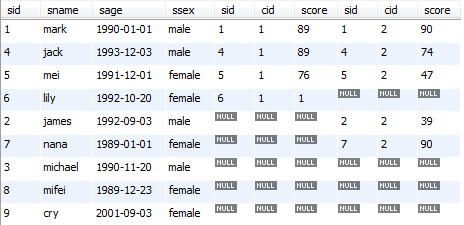
方法三: 这种方法和方法二相同,只是where 子句有所不同,如果想使用方法三,where子句的条件需要修改为b.score>= isnull(c.score),
原因是b.score>isnull(c.score),
假定c.score是null,isnull(c.score)返回的结果为1,那么当b.score=1时,此时b.score>isnull(c.score)不成立,那么这一条记录就会被过滤掉
select a.* , b.score b_score ,c.score c_score from Student a
left join SC b on a.SID = b.SID and b.CID = '01'
left join SC c on a.SID = c.SID and c.CID = '02'
where b.score > = isnull(c.score); #,注意,是>=, 这一句,目的是为了筛选出b表中不为null的成绩,因为isnull(c.score)返回结果只有0和1两种情况
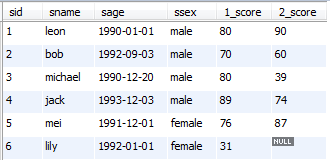
思路解析:
select a.* , b.score b_score ,c.score c_score from Student a
left join SC b on a.SID = b.SID and b.CID = '01'
left join SC c on a.SID = c.SID and c.CID = '02';
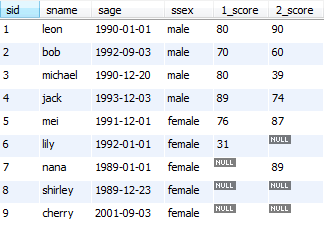
isnull( )使用说明:
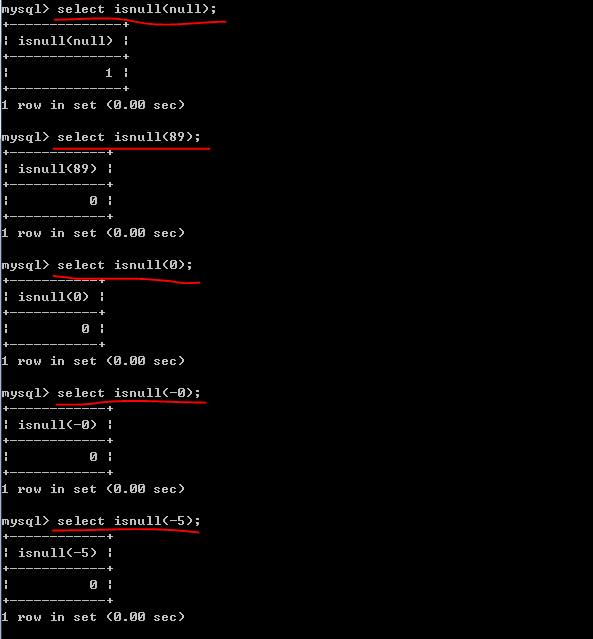
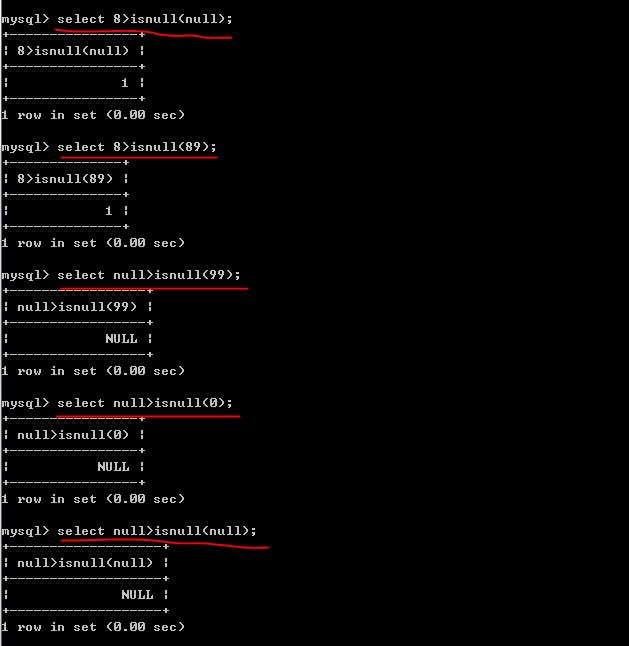
4、查询不存在" 01 "课程但存在" 02 "课程的情况
思路:选修2课程的id号课程中,剔除选修了1课程的id 号
select distinct sid
from sc
where cid=2 and sid not in
(select sid
from sc
where cid=1
);
7、查询所有同学的学生编号、学生姓名、选课总数、所有课程的总成绩(没成绩的显示为 null )
select student.sid, student.sname, count(sc.cid) as "选课总数", sum(sc.score) as "总成绩"
from student left join sc on student.sid=sc.sid
group by student.sid ;
8、查询「李」姓老师的数量
#(例子:查询以s开头的老师数量)
select count(*) from teacher where tname like 's%';
9、查询学过「张三」老师授课的同学的信息
(例子:查询学过 jane 老师授课的学生信息)
select student.*
from student, sc, course, teacher
where student.sid=sc.sid and sc.cid=course.cid and course.tid=teacher.tid and teacher.tname='jane';
中间表:
select *
from student, sc, course, teacher
where student.sid=sc.sid and sc.cid=course.cid and course.tid=teacher.tid ;
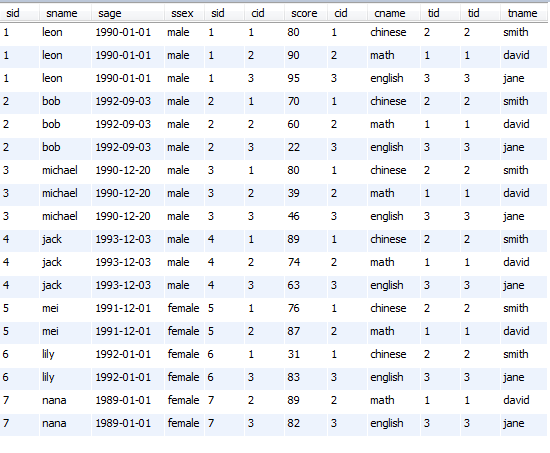
10、查询没有学全所有课程的同学的信息
select student.*
from sc , student
where student.sid=sc.sid
group by sc.sid
having count(sc.cid)<(select count(*) from course); # 查询课程表course中有多少门课
11、查询至少有一门课与学号为" 01 "的同学所学相同的同学的信息
ps:把1号同学排除
select distinct student.*
from student, sc
where student.sid=sc.sid and sc.sid!=1 and sc.cid in (
select distinct cid from sc where sid=1);
12、查询和" 01 "号同学学习的课程 完全相同的其他同学的信息
正确代码:
此时SC表如图:可以看到,将sid分组的情况下,除6号同学外,每个同学的成绩记录都是按照cid增序的顺序插入的;只有6号同学的课程插入顺序是1,3,2

上面这张表不太容易看,对sid按增序排序后,如下图,查看每个同学cid插入的顺序如何,注意:只对sid排序,对cid排序后就不能看出来每个同学cid插入的顺序如何了。
排序后,可以更清楚的看到只有6号同学的课程插入顺序是乱的,不是按照cid增序插入的。
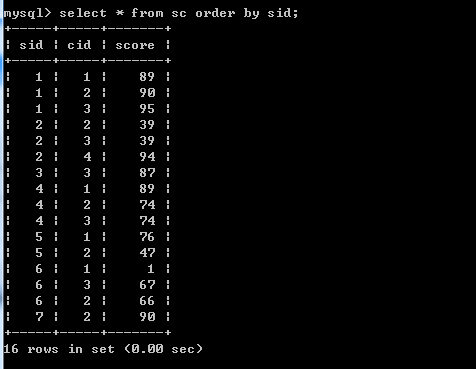
完全正确的代码:
PS:不仅使用了group_concat( )函数,还对group_concat( )函数中的参数进行了排序。
select student.* from (select sid, group_concat(cid order by cid) as tt from sc where sid=1 group by sid order by cid ) a #1号同学选修的课程 #这里对cid进行了排序,因为group_concat()函数连接cid的值时,默认是按照该值在SC表中的插入顺序进行连接的 left join ( select sid, group_concat(cid order by cid) as rr from sc where sid!=1 group by sid order by cid ) b on a.tt=b.rr # #除1号同学外,其他同学选修的课程,将两张表进行连接,按照选修课程相同为条件进行连接 join student on b.sid=student.sid;
运行结果:

下面代码也有漏洞:group _concat( cid)中不对cid排序,则返回结果如下:
select student.* from (select sid, group_concat(cid ) as tt from sc where sid=1 group by sid order by cid ) a left join ( select sid, group_concat(cid ) as rr from sc where sid!=1 group by sid order by cid ) b on a.tt=b.rr join student on b.sid=student.sid;
运行结果:只查询出了4号同学

必须要排序的原因: 可以看到,1,4,6号同学选的课程都一样,只是6号同学课程插入时是乱序的,结果造成下面这种情况,连接的结果也是按插入顺序连接的,这样,系统认为1号同学和6号同学的课程是不一样的,所以group_concat( cid )中要对cid排序,即使用group_concat( cid order by cid)
select sid, group_concat(cid) as '选修课程' from sc group by sid;
运行结果:
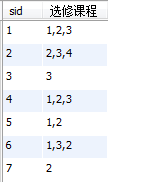
总结:
按同学分组后,如果每个同学的课程插入记录是顺序增加或顺序降低的,则使用group_concat( )函数时不对参数进行排序,没有问题。
但如果每个同学的课程插入记录是乱序的,则使用group_concat( )函数时必须对参数进行排序。
错误代码: 下面的代码看似正确,其实有漏洞,很有迷惑性
分析: 假定一共有4门课,课程号cid=1,2,3,4; SC表如下,其中1同学、4同学、6同学都选修了1,2,3这三门课,不存在选修了全部课程的同学,这种情况下,使用下面代码解决这道题目没有问题,但是

假定表的情况按上述情况,运行下面代码,返回的结果看似是正确的:
select student.*
from sc ,student
where student.sid=sc.sid and sc.cid in ( select cid from sc where sid=1) and student.sid!=1
group by sc.sid
having count(*) in (select count(*) from sc where sid=1);
运行结果:

举一个例子揭示上述代码的漏洞:
在上面的那张表中,插入了一条记录,结果就是6号同学选修了全部课程,那么此时,只有4号同学和1号同学选修的课程完全相同
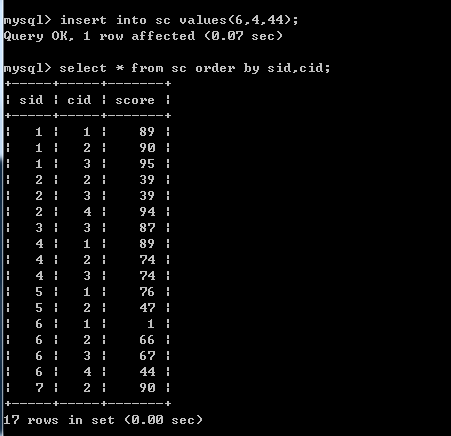
同样运行上面代码,查看运行结果:
select student.*
from sc ,student
where student.sid=sc.sid and sc.cid in ( select cid from sc where sid=1) and student.sid!=1
group by sc.sid
having count(*) in (select count(*) from sc where sid=1);
运行结果: 仍然把6号同学给选了出来,此时,正确的结果应当只有第一条

13、查询没学过"张三"老师讲授的任一门课程的学生姓名
(例子:smith老师)
思路:先把学过smith老师课程的学号选出来,然后从student表中剔除这些学号
select student.*
from student
where sid not in (
select sid from sc ,course, teacher
where sc.cid=course.cid and course.tid=teacher.tid and teacher.tname='smith');
14、查询两门及其以上不及格课程的同学的学号,姓名及其平均成绩
A:查询出两门以上不及格的学号
select sid
from sc
where score<60
group by sid
having count(*)>=2;
A:完整结果
个人理解:我理解的平均成绩某个同学所有选修课程的平均成绩,而不是不及格课程的平均成绩。
例如,2号同学选了3门课,有2门不及格,平均成绩是指3门的平均成绩,而不是2门的。
select student.sid, student.sname, avg(sc.score)
from (student join sc on student.sid=sc.sid ) join
(
select sc.sid as esid
from sc
where sc.score<60
group by sc.sid
having count(*)>=2) a
on student.sid=a.esid
group by student.sid
order by student.sid;
运行结果:

15、检索" 01 "课程分数小于 60,按分数降序排列的学生信息
select student.*
from sc,student
where cid=1 and score<60 and sc.sid=student.sid
order by score desc;
16、按平均成绩从高到低显示所有学生的所有课程的成绩以及平均成绩
select sc.*, a.avgscore
from sc left join (select sid, avg(score) as avgscore from sc group by sid) a on sc.sid=a.sid
order by a.avgscore desc;
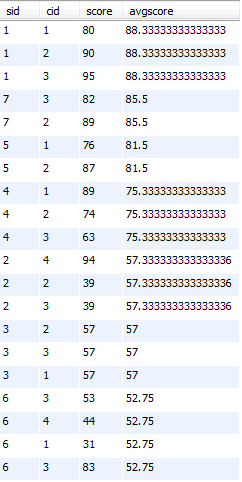
17、查询各科成绩最高分、最低分和平均分
select cid, max(score), min(score), avg(score)
from sc
group by cid;
18、以如下形式显示:课程 ID,课程 name,最高分,最低分,平均分,及格率,中等率,优良率,优秀率
及格为>=60,中等为:70-80,优良为:80-90,优秀为:>=90
要求输出课程号和选修人数,查询结果按人数降序排列,若人数相同,按课程号升序排列
select sc.cid, course.cname,count(sc.sid) as '选修人数', max(sc.score), min(score), avg(score),
(sum(case when score>=60 then 1 else 0 end)/count(sc.sid)) as '及格率',
(sum(case when score>=70 and score<80 then 1 else 0 end) /count(sc.sid)) as '中等率',
(sum(case when score>=80 and score<90 then 1 else 0 end)/count(sc.sid)) as '优良率',
(sum(case when score>=90 then 1 else 0 end)/count(sc.sid)) as '优秀率'
from sc, course
where sc.cid=course.cid
group by sc.cid
order by count(sc.sid) desc, cid ; #按选修人数降序排列,如果人数相同,按课程号cid升序排列
19、按各科成绩进行排序,并显示排名, Score 重复时保留名次空缺
思路:这里不能使用a.score<=b.score
select a.sid ,a.cid, a.score, count(a.score<b.score)+1 as rank
from sc a left join sc b on a.cid=b.cid and a.score<b.score
group by a.cid, a.sid
order by a.cid, a.score desc;
20、按各科成绩进行排序,并显示排名, Score 重复时合并名次
思路:看某个分数在所有分数中,小于等于的有几个
select a.sid ,a.cid, a.score, count( distinct b.score)+1 as rank
from sc a left join sc b on a.cid=b.cid and a.score<b.score
group by a.cid, a.sid
order by a.cid, a.score desc;
或者 如果是a.score<=b.score,则count( distinct b.score) 即可,不用加1
select a.sid ,a.cid, a.score, count( distinct b.score) as rank
from sc a left join sc b on a.cid=b.cid and a.score<=b.score
group by a.cid, a.sid
order by a.cid, a.score desc;
21、查询学生的总成绩,并进行排名,总分重复时保留名次空缺
select a.* ,count(a.cj<b.cj)+1 as rank
from
(select sid , sum(score) as cj from sc group by sid) a
left join
( select sid, sum(score) as cj from sc group by sid) b
on a.cj<b.cj
group by a.sid
order by a.cj desc
;
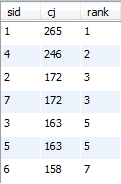
22、 查询学生的总成绩,并进行排名,总分重复时不保留名次空缺
select a.* ,count(distinct b.cj)+1 as rank
from
(select sid , sum(score) as cj from sc group by sid) a
left join
( select sid, sum(score) as cj from sc group by sid) b
on a.cj<b.cj
group by a.sid
order by a.cj desc
;
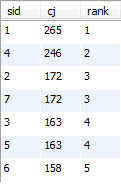
23、统计各科成绩各分数段人数:课程编号,课程名称,[100-85],[85-70],[70-60],[60-0] 及所占百分比
select sc.cid,cname,count(sid) as '总人数',
concat(round(sum(case when score>=0 and score<60 then 1 else 0 end) /count(sid)*100,2),'%') as '0-60',
concat(round(sum(case when score>=60 and score<70 then 1 else 0 end)/count(sid)*100,2),"%") as '60-70',
concat(round(sum(case when score>=70 and score<85 then 1 else 0 end)/count(sid)*100,2),"%") as '70-85',
concat(round(sum(case when score<=100 and score>=85 then 1 else 0 end )/count(*)*100,2),'%') as '85-100'
from sc join course on sc.cid=course.cid
group by cid;
24、查询各科成绩前三名的记录
思路:先将各科成绩进行排序(这里应该是不保留名次空缺),然后从成绩表SC中选出排名<=3的记录
select * from
(
select a.*, count(distinct b.score) +1 as rank
from sc a
left join sc b
on a.cid=b.cid and a.score<b.score
group by a.cid, a.sid
order by a.cid, a.score desc) c
where c.rank<=3
;
25、查询每门课程被选修的学生数
select cid, count(*) as '选修人数'
from sc
group by cid;
26、查询出只选修两门课程的学生学号和姓名
select sc.sid, student.sname
from student, sc
where student.sid=sc.sid
group by sc.sid
having count(sc.cid)=2;
27、查询男生、女生人数
select ssex as '性别' , count(*) as '人数'
from student
group by ssex;
28、查询名字中含有「风」字的学生信息
select * from student where sname like '%m%'; #这个是查询姓名含有m的学生信息,m在开头或者中间位置都可以
select * from student where sname like 'm%'; #这个是查询姓名以m开头的学生信息
29、查询同名同姓学生名单,并统计同名人数
select sname , count(*) as '人数'
from student
group by sname;
30、查询 1990 年出生的学生名单
select * from student where sage like "1990%" ;
31、查询每门课程的平均成绩,结果按平均成绩降序排列,平均成绩相同时,按课程编号升序排列
select cid, avg(score) as '平均成绩'
from sc
group by cid
order by avg(score) desc, cid;
32、查询平均成绩大于等于 85 的所有学生的学号、姓名和平均成绩
select student.sid, student.sname, a.pj
from student join
(select sid, avg(score) as 'pj'
from sc
group by sid
having avg(score)>=85) a
on student.sid=a.sid ;
33、查询课程名称为「数学」,且分数低于 60 的学生姓名和分数
select student.sname, score
from student, sc, course
where student.sid=sc.sid and sc.cid=course.cid and score<60 and cname='math';
34、查询所有学生的课程及分数情况(存在学生没成绩,没选课的情况)
select student.sid,student.sname, sc.cid,sc.score
from student left join sc on student.sid=sc.sid
order by student.sid;
| 1 | mark | 1 | 80 |
| 1 | mark | 3 | 95 |
| 1 | mark | 2 | 90 |
| 2 | james | 2 | 39 |
| 2 | james | 3 | 39 |
| 2 | james | 4 | 94 |
| 3 | michael | 1 | 93 |
| 3 | michael | 3 | 87 |
| 4 | jack | 2 | 74 |
| 4 | jack | 1 | 89 |
| 4 | jack | 3 | 83 |
| 5 | mei | 1 | 76 |
| 5 | mei | 2 | 47 |
| 6 | lily | 4 | 44 |
| 6 | lily | 1 | 41 |
| 6 | lily | 3 | 83 |
| 7 | nana | 3 | 83 |
| 7 | nana | 2 | 89 |
| 8 | mifei | NULL | NULL |
| 9 | cry | NULL | NULL |
35、查询任何一门课程成绩在 70 分以上的姓名、课程名称和分数
select sname, cname ,score
from (sc join student on sc.sid=student.sid) join course on sc.cid=course.cid
where score>70
order by sc.sid;
36、查询不及格的课程
select course.cname, sc.score
from sc join course on sc.cid=course.cid
where sc.score<60;
37、查询课程编号为 01 且课程成绩在 80 分以上的学生的学号和姓名
select student.sid, student.sname
from student ,sc
where student.sid=sc.sid and sc.cid=1 and sc.score>80
order by cid ;
38、求每门课程的学生人数
select cid, count(*) as '该课程的选修人数'
from sc
group by cid;
39、成绩不重复,查询选修「张三」老师所授课程的学生中,成绩最高的学生信息及其成绩
40、成绩有重复的情况下,查询选修「张三」老师所授课程的学生中,成绩最高的学生信息及其成绩
PS:这两道题,使用下面同样的代码都能运行出正确结果
select student.*, a.score from sc a left join sc b on a.cid=b.cid and a.score<b.score #对每门课程下的学生成绩排名 join course on a.cid=course.cid join teacher on course.tid=teacher.tid and tname='张三' #这一行和上一行,是为了筛选张三老师教的课 join student on a.sid=student.sid # 获取学生信息 group by a.cid, a.sid having count( a.score< b.score)=0 #筛选名次rank=1, count(a.score<b.score)+1=1,两端减去1,简化为count(a.score<b.score)=0 #上面这一行having 子句,这种格式也可以:having count( distinct b.score)=0 ,使用distinct ;
41、查询不同课程成绩相同的学生的学生编号、课程编号、学生成绩
select sc.cid , sc.sid, sc.score from sc join (select cid, score from sc group by cid, score having count(sid)>=2) a on sc.cid=a.cid and sc.score=a.score order by cid ;
或
select sc.sid, sc.cid , sc.score from sc join (select sid, score from sc group by sid, score having count(cid)>=2) a on sc.sid=a.sid and sc.score=a.score order by sid;
42、查询每门功成绩最好的前两名
思路:先对每门课程下的成绩排序,然后筛选排名<=2的
select a.cid, a.sid, sname, a.score, count(distinct b.score)+1 as 'rank'
from ( sc a left join sc b on a.cid=b.cid and a.score<b.score) join student on a.sid=student.sid
group by a.cid, a.sid
having rank<=2
order by cid
;
43、统计每门课程的学生选修人数(超过 5 人的课程才统计)
select sc.cid,cname,count(sid) as '选修人数'
from sc join course on sc.cid=course.cid
group by sc.cid
having count(sid)>4;
44、检索至少选修两门课程的学生学号
select sid
from sc
group by sid
having count(cid)>=2;
45、查询选修了全部课程的学生信息
select student.*
from sc join student on sc.sid=student.sid
group by sid
having count(*) in (
select count(*) from course);
计算年龄,只按年份来算和按月日来算的区别
46、查询各学生的年龄,只按年份来算
select student.sid, student.sname,student.ssex, year(now())-year(student.sage) as 'age'
from student;
47、按照出生日期来算,当前月日 < 出生年月的月日则,年龄减一
select student.sid, student.sname,student.ssex, sage,
timestampdiff(year,sage,now()) as '按月日计算', # 出生月日< 当前日期的月日时,年龄会减一 ,该题目功能是通过这一句实现的,下一句只是为了对比说明两者之间的差别
year(now())-year(sage) as '按年份计算'
from student;
48、查询本周过生日的学生
select * from student where week(concat_ws('-',year(now()),date_format(sborn,'%m-%d')))=week(now());
49、查询下周过生日的学生
select * from student where week(concat_ws('-',year(now()),date_format(sborn,'%m-%d')))=week(now())+1;
50、查询本月过生日的学生
select *
from student
where month(student.sage)=month(now());
51、查询下月过生日的学生
select *
from student
where month(student.sage)=month(now())+1;




